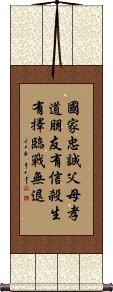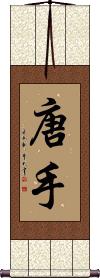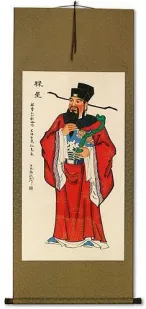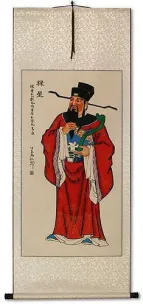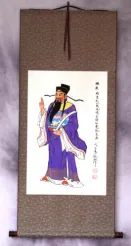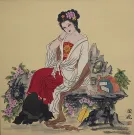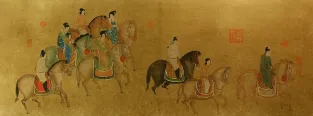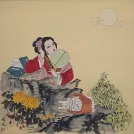Many custom options...
And formats...

Not what you want?
Try other similar-meaning words, fewer words, or just one word.
Lu Tang in Chinese / Japanese...
Buy a Lu Tang calligraphy wall scroll here!
Personalize your custom “Lu Tang” project by clicking the button next to your favorite “Lu Tang” title below...
Switched to secondary search mode due to lack of results using primary.
These secondary results may not be very accurate. Try a different but similar meaning word or phrase for better results. Or...
Look up Lu Tang in my Japanese Kanji & Chinese Character Dictionary(My dictionary is a different system then the calligraphy search you just tried)
If you want a special phrase, word, title, name, or proverb, feel free to contact me, and I will translate your custom calligraphy idea for you.
Five Codes of Tang Soo Do
国家忠诚父母孝道朋友有信杀生有择临战无退 are the five codes of Tang Soo Do.
I suggest you have this arranged in five columns when you get to the options page for your custom calligraphy wall scroll.
Here are my translations of each of the five codes:
國家忠誠 Be loyal to your country.
父母孝道 In regards to parents, behave in a filial way.
朋友有信 Be faithful in friendship.
殺生有擇 When fighting for life and death, make noble choices.
臨戰無退 No retreat in battle.
Note: “Tang Soo Do” is a romanization of 唐手道. It's 당수도 in Korean Hangul. It can also be romanized as “Tangsudo” or “Dangsudo.”
Tang Soo Do / Tang Hand Way
唐手道 is the alternate title for Karate-do.
This title uses a character, 唐, which represents the Tang Dynasty of China. Thus, this is often translated as the “Tang Hand Way” or incorrectly, “Tang Fist Way.”
I have also seen some call it “China Hand Way.”
Many in Korea refer to and romanize these characters as “Tang Soo Do” (당수도) where these characters refer to a kind of Korean style of Karate.
There is not a lot of information on this title but some believe that a simplified form of Kung Fu that started in China and ended up very popular in Japan used this title initially. It was later changed in Japan to a different Karate title which means “Empty Hand” (as in, without weapons).
Note: When used in Korean, this is pronounced 당수도. This title is often romanized as “Tang Soo Do,” “Tangsudo,” “Dang Su Do,” or “Dangsudo.” The last two romanizations on that list are the official Korean government romanization, though martial arts schools tend to use other non-standard versions.
Tang Hand
唐手 is a very seldom-used title for Karate.
This title uses a character that represents the Tang Dynasty of China. Thus, this is often translated as the “Tang Hand” or, incorrectly, “Tang Fist.”
I have also seen some call it “China Hand.”
There is not a lot of information on this title but some believe that a simplified form of Kung Fu that started in China, and ended up very popular in Japan used this title initially. It was later changed in Japan to a different Karate title which means "Empty Hand" (as in, without weapons).
I am sure that some will suggest a different history or argue a different origin. I think that nobody can be sure.
Note: Just like the more conventional Karate title, this one can have the "way" or "method" character added to the end, as in Karate-Do.
Tang Soo Do Tenets
廉耻精進忍耐遵守克己謙遜百折不屈 are the tenets of Tang Soo Do.
| English | Old Hanja | Modern Hangul | Pronunciation |
| 1. Integrity | 廉耻 | 렴치 or 염치 | yeom ci |
| 2. Concentration | 精進 | 정진 | jeong jin |
| 3. Perseverance | 忍耐 | 인내 | in nae |
| 4. Respect & Obedience | 遵守 | 준수 | jun su |
| 5. Self-Control | 克己 | 극기 | geug gi |
| 6. Humility | 謙遜 | 겸손 | gyeom son |
| 7. Indomitable Spirit | 百折不屈 | 백절불굴 | baeg jeor bur gur |
After some research, it appears this list was compiled in English based on Taekwondo tenets. We filled in a few of the words that did not have a corresponding Hanja or Hangul. If someone else has a better list with characters included, please contact me.
Fu Lu Shou
These are the short titles for Sanxing or 三星 (Three Stars).
福祿壽 are the gods of Jupiter, Ursa Major, and Sirius. Fu, Lu, and Shou represent fortune (福), presiding over the planet Jupiter, prosperity (祿), presiding over Ursa Major, and longevity (壽), presiding over Sirius.
In old Chinese folk religion, they are often represented as three old bearded wise men.
This in-stock artwork might be what you are looking for, and ships right away...
Gallery Price: $120.00
Your Price: $69.88
Gallery Price: $120.00
Your Price: $59.88
Lu Xing
God of Money and Prosperity
Wall Scroll
Discounted Blemished
Gallery Price: $71.00
Your Price: $39.00
God of Money and Prosperity
Lu Xing
Wall Scroll
Discounted Blemished
Gallery Price: $53.00
Your Price: $29.00
Gallery Price: $180.00
Your Price: $99.88
Gallery Price: $180.00
Your Price: $99.88
Tang Dynasty Beautiful Chinese Woman Painting
Discounted Blemished
Gallery Price: $107.00
Your Price: $59.00
Gallery Price: $150.00
Your Price: $79.88
Gallery Price: $100.00
Your Price: $59.88
Not the results for lu tang that you were looking for?
Below are some entries from our dictionary that may match your lu tang search...
| Characters If shown, 2nd row is Simp. Chinese |
Pronunciation Romanization |
Simple Dictionary Definition |
唐 see styles |
táng tang2 t`ang tang tou / to とう |
More info & calligraphy: Donn(1) (hist) Tang dynasty (of China; 618-907); T'ang dynasty; (2) (archaism) China; foreign country; (surname) Touzaki for nothing |
道 see styles |
dào dao4 tao dou / do どう |
More info & calligraphy: Daoism / Taoism(1) (abbreviation) (See 道・みち・1) road; path; street; route; (2) (See 道・みち・5) way; set of practices; rules for conducting oneself; (3) (abbreviation) (in Japanese schools) (See 道徳教育) moral education; (4) Buddhist teachings; (5) Taoism; (6) administrative region of Japan (Hokkaido); (7) (hist) administrative region of Japan (Tokaido, Tosando, etc.); (8) province (administrative region of Korea); (9) circuit (administrative region of China); (10) (hist) province (Tang-era administrative region of China); (personal name) Wataru mārga. A way, road; the right path; principle, Truth, Reason, Logos, Cosmic energy; to lead; to say. The way of transmigration by which one arrives at a good or bad existence; any of the six gati, or paths of destiny. The way of bodhi, or enlightenment leading to nirvāṇa through spiritual stages. Essential nirvāṇa, in which absolute freedom reigns. For the eightfold noble path v. 八聖道.; The two Ways: (1) (a) 無礙道 or 無間道 The open or unhindered way, or the way of removing all obstacles or intervention, i. e. all delusion; (b) 解脫道 the way of release, by realization of truth. (2) (a) 難行道 The hard way of "works", i. e. by the six pāramitā and the disciplines. (b) 易行道 the easy way salvation, by the invocation of Amitābha. (3) (a) 有漏道 The way of reincarnation or mortality; (b) 無漏 the enlightened way of escape from the miseries of transmigration. (4) (a) 教道 The way of instruction; (b) 證道 the way of realization. (5) The two lower excretory organs. |
印度 see styles |
yìn dù yin4 du4 yin tu indo いんど |
More info & calligraphy: India(ateji / phonetic) (kana only) India; (place-name) India 印特伽; 身毒; 賢豆; 天竺 Indu (meaning 'moon' in Sanskrit), Hindu, Sindhu; see also 信度 and 閻浮 India in general. In the Tang dynasty its territory is described as extending over 90, 000 li in circuit, being bounded on three sides by the sea; north it rested on the Snow mountains 雪山, i. e. Himālayas; wide at the north, narrowing to the south, shaped like a half-moon; it contained over seventy kingdoms, was extremely hot, well watered and damp; from the centre eastwards to 震旦 China was 58, 000 li; and the same distance southwards to 金地國, westwards to 阿拘遮國, and northwards to 小香山阿耨達. |
天皇 see styles |
tiān huáng tian1 huang2 t`ien huang tien huang tennou / tenno てんのう |
More info & calligraphy: Emperor of JapanEmperor of Japan; (place-name) Tennou Deva-king; the Tang monk 道悟 Daowu of the 天皇 Tianhuang monastery at 荊州 Jingzhou. |
復古 复古 see styles |
fù gǔ fu4 gu3 fu ku fukko ふっこ |
More info & calligraphy: Retro / Old School(n,vs,vt,vi,adj-no) revival; restoration |
魏徵 魏征 see styles |
wèi zhēng wei4 zheng1 wei cheng |
More info & calligraphy: Wei Zheng |
唐手道 see styles |
táng shǒu dào tang2 shou3 dao4 t`ang shou tao tang shou tao |
More info & calligraphy: Tang Soo Do / Tang Hand Way |
花木蘭 花木兰 see styles |
huā mù lán hua1 mu4 lan2 hua mu lan |
More info & calligraphy: Hua Mulan |
菩提樹 菩提树 see styles |
pú tí shù pu2 ti2 shu4 p`u t`i shu pu ti shu bodaiju; bodaiju ぼだいじゅ; ボダイジュ |
More info & calligraphy: The Tree of Enlightenment / The Bodhi Tree(1) Tilia miqueliana (species of linden tree); (2) (See インドボダイジュ) sacred fig (Ficus religiosa); bodhi tree; bo tree; peepal tree; pipal tree; (given name) Bodaiju bodhidruma, bodhitaru, bodhivṛkṣa; the wisdom-tree, i.e. that under which Śākyamuni attained his enlightenment, and became Buddha. The Ficus religiosa is the pippala, or aśvattha, wrongly identified by Faxian as the palm-tree; it is described as an evergreen, to have been 400 feet high, been cut down several times, but in the Tang dynasty still to be 40 or 50 feet high. A branch of it is said to have been sent by Aśoka to Ceylon, from which sprang the celebrated Bo-tree still flourishing there. |
卿 see styles |
qīng qing1 ch`ing ching kei / ke けい |
high ranking official (old); term of endearment between spouses (old); (from the Tang Dynasty onwards) term used by the emperor for his subjects (old); honorific (old) (pronoun) (1) (honorific or respectful language) (masculine speech) (archaism) (used to address someone of equal or lower status) you; (pronoun) (2) (honorific or respectful language) (archaism) (used by a ruler to address a subject) you; (given name) Akira you |
堯 尧 see styles |
yáo yao2 yao takashi たかし |
surname Yao; Yao or Tang Yao (c. 2200 BC), one of the Five legendary Emperors 五帝[Wu3 Di4], second son of Di Ku 帝嚳|帝喾[Di4 Ku4] (surname, given name) Takashi |
府 see styles |
fǔ fu3 fu fu ふ |
seat of government; government repository (archive); official residence; mansion; presidential palace; (honorific) Your home; prefecture (from Tang to Qing times) (1) (urban) prefecture (i.e. Osaka and Kyoto); (2) centre (e.g. of learning); center; seat; (3) (government) office; (4) (hist) fu (administrative unit in China, Korea and Vietnam); (surname) Futaka |
斛 see styles |
hú hu2 hu teruo てるお |
ancient measuring vessel; fifty liters; dry measure for grain equal to five dou 五斗 (before Tang, ten pecks) (1) measure of volume (approx. 180.39 liters, 6.37 cub. ft.); (2) measure of a Japanese-style boat's loading capacity (approx. 278.26 liters); (personal name) Teruo droṇa, a tub, or wooden vessel; a measure of capacity. A square wooden vessel, a bushel, a picul. |
曌 see styles |
zhào zhao4 chao |
name invented for herself by Tang empress Wu Zetian 武則天|武则天[Wu3 Ze2 tian1] |
浣 see styles |
huàn huan4 huan kan かん |
to wash; to rinse; any of three 10-day division of the month (during Tang dynasty); Taiwan pr. [huan3]; also pr. [wan3] (given name) Kan to wash |
湯 汤 see styles |
tāng tang1 t`ang tang tan タン |
soup; hot or boiling water; decoction of medicinal herbs; water in which something has been boiled soup (chi: tāng); (personal name) Yumine Hot liquid, hot water, soup, etc. |
溵 see styles |
yīn yin1 yin |
used in place-names, e.g. 溵水 was once the name of the Shahe River 沙河, Henan, and 溵州 was a Tang Dynasty prefecture |
行 see styles |
xíng xing2 hsing kou / ko こう |
to walk; to go; to travel; a visit; temporary; makeshift; current; in circulation; to do; to perform; capable; competent; effective; all right; OK!; will do; behavior; conduct; Taiwan pr. [xing4] for the behavior-conduct sense (n,n-suf) (1) going; travelling; traveling; journey; trip; (2) act; action; (suffix noun) (3) bank; (counter) (4) counter for banks; (counter) (5) counter for groups or parties of people; (6) type of classical Chinese verse (usu. an epic from the Tang period onwards); (7) (hist) shopping district (of similar merchants; in the Sui and Tang periods); (8) (hist) merchants' guild (in the Tang period); (female given name) Yukue Go; act; do; perform; action; conduct; functioning; the deed; whatever is done by mind, mouth, or body, i.e. in thought, word, or deed. It is used for ayana, going, road, course; a march, a division of time equal to six months; also for saṁskāra, form, operation, perfecting, as one of the twelve nidānas, similar to karma, action, work, deed, especially moral action, cf. 業. |
霫 see styles |
xí xi2 hsi |
Sui-Tang (premodern ethnic group) |
騰 腾 see styles |
téng teng2 t`eng teng noboru のぼる |
(bound form) to gallop; to prance; (bound form) to soar; to hover; to make room; to clear out; to vacate; (verb suffix indicating repeated action) (given name) Noboru To mount, rise; translit. tang. |
三武 see styles |
sān wǔ san1 wu3 san wu mitsutake みつたけ |
(personal name) Mitsutake The three emperors Wu who persecuted Buddhism: 太武 of the Wei dynasty A.D. 424-452; 武帝 of the Zhou A.D. 561-578; 武宗 of the Tang A.D. 841-7. |
上人 see styles |
shàng rén shang4 ren2 shang jen shounin / shonin しょうにん |
holy priest; saint; (place-name) Shounin A man of superior wisdom, virtue, and conduct, a term applied to monks during the Tang dynasty. |
不可 see styles |
bù kě bu4 ke3 pu k`o pu ko fuka ふか |
cannot; should not; must not (adj-no,adj-na,n,n-suf) (1) wrong; bad; improper; unjustifiable; inadvisable; (adj-no,adj-na,n,n-suf) (2) not allowed; not possible; (3) failing grade; (place-name) Yobazu May not, can not: unpermissible, for-bidden; unable. Buke, the name of a monk of the 靈妙寺 Ling Miao monastery in the Tang dynasty, a disciple of Subha-karāṣimha, and one of the founders of 眞言 Shingon. |
中古 see styles |
zhōng gǔ zhong1 gu3 chung ku chuuko(p); chuuburu / chuko(p); chuburu ちゅうこ(P); ちゅうぶる |
medieval; Middle Ages; Chinese middle antiquity, 3rd to 9th centuries, including Sui and Tang Dynasties; Middle (of a language, e.g. Middle English); used; second-hand (can be adjective with の) (1) used; second-hand; old; (2) (ちゅうこ only) Middle Ages (in Japan esp. Heian period); (surname) Chuuko |
中子 see styles |
zhōng zǐ zhong1 zi3 chung tzu mitsuko みつこ |
neutron (1) core; (2) tang (of a sword, etc.); (3) middle of a nest of boxes; (female given name) Mitsuko |
乾陵 see styles |
qián líng qian2 ling2 ch`ien ling chien ling |
Qianling at Xianyang 咸陽市|咸阳市 in Shaanxi, burial site of third Tang emperor 高宗 and empress Wuzetian 武則天|武则天 |
五代 see styles |
wǔ dài wu3 dai4 wu tai godai ごだい |
Five Dynasties, period of history between the fall of the Tang dynasty (907) and the founding of the Song dynasty (960), when five would-be dynasties were established in quick succession in North China (hist) (See 五代十国・ごだいじっこく,後梁・こうりょう,後唐・こうとう,後晋・こうしん,後漢・ごかん・2,後周・こうしゅう) Five Dynasties (of China; 907-979); (p,s,f) Godai |
五帝 see styles |
wǔ dì wu3 di4 wu ti gotai |
the Five Legendary Emperors, usually taken to be the Yellow Emperor 黃帝|黄帝[Huang2 di4], Zhuanxu 顓頊|颛顼[Zhuan1 xu1], Di Ku 帝嚳|帝喾[Di4 Ku4], Tang Yao 唐堯|唐尧[Tang2 Yao2] and Yu Shun 虞舜[Yu2 Shun4] five emperors |
五時 五时 see styles |
wǔ shí wu3 shi2 wu shih goji |
(五時教) The five periods or divisions of Śākyamuni's teaching. According to Tiantai they are (1) 華嚴時 the Avataṃsaka or first period in three divisions each of seven days, after his enlightenment, when he preached the content, of this sutra; (2) 鹿苑時 the twelve years of his preaching the Āgamas 阿含 in the Deer Park; (3) 方等時 the eight years of preaching Mahāyāna-cum-Hīnayāna doctrines, the vaipulya period; (4) 般若時 the twenty-two years of his preaching the prajñā or wisdom sutras; (5) 法華涅槃時 the eight years of his preaching the Lotus Sutra and, in a day and a night, the Nirvana Sutra. According to the Nirvana School (now part of the Tiantai) they are (1) 三乘別教 the period when the differentiated teaching began and the distinction of the three vehicles, as represented by the 四諦 Four Noble Truths for śrāvakas, the 十二因緣 Twelve Nidānas for pratyekabuddhas, and the 六度 Six Pāramitās for bodhisattvas; (2) 三乘通教 the teaching common to all three vehicles, as seen in the 般若經; (3) 抑揚教 the teaching of the 維摩經, the 思益梵天所問經, and other sutras olling the bodhisattva teaching at the expense of that for śrāvakas; (4) 同歸教 the common objective teaching calling all three vehicles, through the Lotus, to union in the one vehicle; (5) 常住教 the teaehmg of eternal life i. e. the revelation through the Nirvana sutra of the eternity of Buddhahood; these five are also called 有相; 無相; 抑揚; 曾三歸—; and 圓常. According to 劉虬 Liu Chiu of the 晉 Chin dynasty, the teaching is divided into 頓 immediate and 漸 gradual attainment, the latter having five divisions called 五時教 similar to those of the Tiantai group. According to 法寶 Fabao of the Tang dynasty the five are (1) 小乘; (2) 般着 or 大乘; (3) 深密 or 三乘; (4) 法華 or 一乘; (5) 涅槃 or 佛性教. |
伊州 see styles |
yī zhōu yi1 zhou1 i chou |
Tang dynasty province in modern Xinjiang, around Hami 哈密[Ha1 mi4]; Illinois (US state) |
Click here for more lu tang results from our dictionary
The following table may be helpful for those studying Chinese or Japanese...
| Title | Characters | Romaji (Romanized Japanese) | Various forms of Romanized Chinese | |
| Five Codes of Tang Soo Do | 國家忠誠父母孝道朋友有信殺生有擇臨戰無退 国家忠诚父母孝道朋友有信杀生有择临战无退 | guó jiā zhōng chéng fù mǔ xiào dào péng yǒu yǒu xìn shā shēng yǒu zé lín zhàn wú tuì guo2 jia1 zhong1 cheng2 fu4 mu3 xiao4 dao4 peng2 you3 you3 xin4 sha1 sheng1 you3 ze2 lin2 zhan4 wu2 tui4 guo jia zhong cheng fu mu xiao dao peng you you xin sha sheng you ze lin zhan wu tui | kuo chia chung ch`eng fu mu hsiao tao p`eng yu yu hsin sha sheng yu tse lin chan wu t`ui kuo chia chung cheng fu mu hsiao tao peng yu yu hsin sha sheng yu tse lin chan wu tui |
|
| Tang Soo Do Tang Hand Way | 唐手道 | kara te do / karatedo | táng shǒu dào tang2 shou3 dao4 tang shou dao tangshoudao | t`ang shou tao tangshoutao tang shou tao |
| Tang Hand | 唐手 | kara te / karate | táng shǒu tang2 shou3 tang shou tangshou | t`ang shou tangshou tang shou |
| Tang Soo Do Tenets | 廉耻精進忍耐遵守克己謙遜百折不屈 / 廉恥精進忍耐遵守克己謙遜百折不屈 廉耻精进忍耐遵守克己谦逊百折不屈 | lián chǐ jīng jìn rěn nài zūn shǒu kè jǐ qiān xùn bǎi zhé bù qū lian2 chi3 jing1 jin4 ren3 nai4 zun1 shou3 ke4 ji3 qian1 xun4 bai3 zhe2 bu4 qu1 lian chi jing jin ren nai zun shou ke ji qian xun bai zhe bu qu | lien ch`ih ching chin jen nai tsun shou k`o chi ch`ien hsün pai che pu ch`ü lien chih ching chin jen nai tsun shou ko chi chien hsün pai che pu chü |
|
| Fu Lu Shou | 福祿壽 | fú lù shòu fu2 lu4 shou4 fu lu shou fulushou | ||
| In some entries above you will see that characters have different versions above and below a line. In these cases, the characters above the line are Traditional Chinese, while the ones below are Simplified Chinese. | ||||
Successful Chinese Character and Japanese Kanji calligraphy searches within the last few hours...
